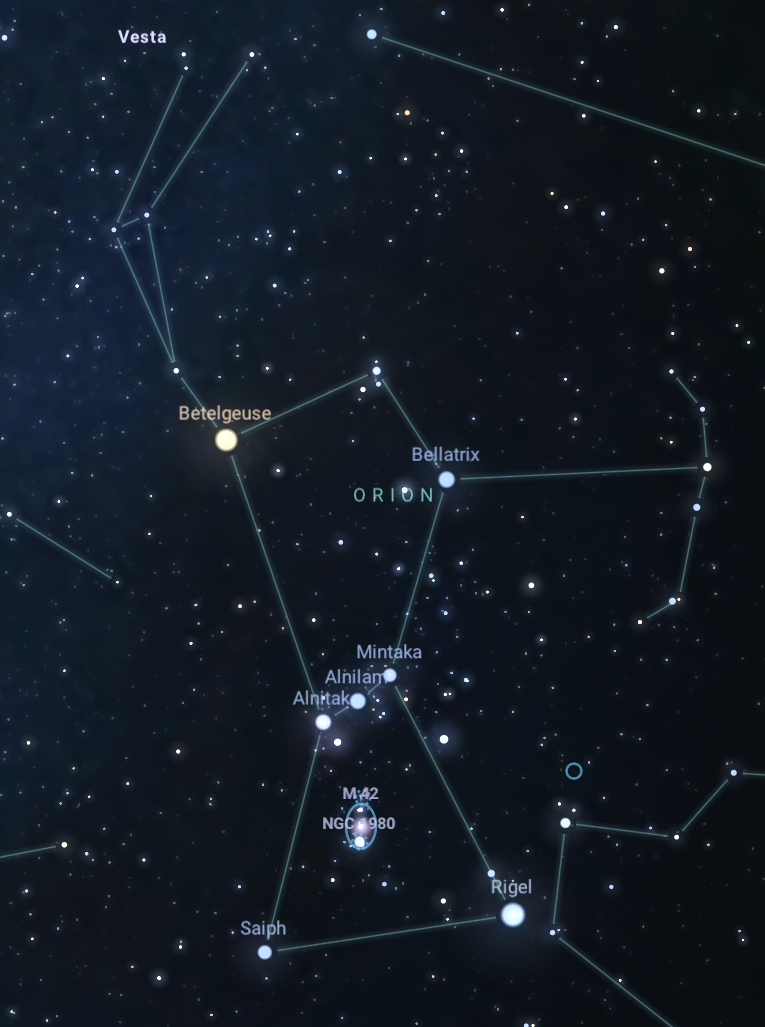Stargazers seeking familiar points of interest in the night sky are likely to point out Betelgeuse, the red supergiant star sometimes identified as “the shoulder of Orion.” Even some 400-600 light-years distant, it’s typically one of the brightest stars visible in the night sky, and the brightest of all in the infrared spectrum.
Fewer space enthusiasts may know that Betelgeuse’s nickname may have been mistranslated from the Arabic phrase Ibṭ al-Jauzā’ in the 13th century. Depending on the nuances of pronunciation, Betelgeuse actually might be “the armpit of Orion.”

What may come as a surprise is that the star that inspired the naming of a ghostly movie menace is doing some hurtling of its own. Betelgeuse is actually a runaway star in the process of bidding a big galactic adios to its birthplace – the hot star association that includes Orion’s Belt – and speeding away at approximately 18.6 miles per second.
That’s an awesome prospect, said Dr. Debra Wallace, Marshall’s Deputy Branch Chief of Astrophysics. Betelgeuse is a pulsating star with an uncertain distance of roughly 548 light-years and changing luminosity. We estimate its radius is approximately 724 times larger than our Sun. If it sat at the center of our solar system, it would swallow the orbits of Mercury, Venus, Earth, and Mars. Its bow shock – the “wave” generated by its passage through the interstellar medium – is roughly four light-years across.
What cosmic force caused Betelgeuse to go on the interstellar lam from its point of origin?
“Typically, stars don’t become runaways without receiving a big kick,” Wallace said. “What’s most likely is that the competing gravity of other nearby stars ejected it outward or something else blew up in its proximity. There was a change in the dynamic interactions of the star grouping, and Betelgeuse was sent packing.”
Betel-BOOM!
Betelgeuse is only 10 million years old, but already in the twilight of its life. Given that our own small star is nearly 5 billion years, roughly halfway through its own estimated lifespan, why is Betelgeuse expected to be here today and gone tomorrow – give or take 100,000 years?
“Think about setting a fire in your back yard,” Wallace said. “The more fuel you throw on it, the faster and hotter it burns. It’s visually impressive – but gone in a flash.”
That’s because stars ignite a powerful chain of nuclear fusion reactions to counter their own intense gravity, which is always striving to collapse the star in on itself. For supergiants such as Betelgeuse, that delicate balance requires it to burn extremely hot and bright – but that also means it consumes its fuel supply far faster than our own modest young star.
Wallace said Betelgeuse likely started its life at least 20 times the mass of Earth’s Sun. It’s been visible to us for millennia. Ancient Chinese astronomers would have identified it as a yellow star which has since evolved to the right, per the Hertzsprung-Russell stellar evolution diagram and a 2022 study of the star’s color evolution. When the Egyptian astronomer Ptolemy saw Betelgeuse some 300 years after the earliest Chinese observations, it had gone orange. Today, the star has taken on a fierce red color that makes it easy to find in the night sky.
“Betelgeuse likely will burn for another 100,000 years or so, depending on its mass loss rate, then could end up a blue supergiant – like Rigel, the star that serves as Orion’s right knee – before it explodes,” Wallace said. That supernova event, she noted, will release as much energy in a split-second as our Sun generates in its entire lifetime, though Betelgeuse is far too distant to have any effect on our solar system.

Credits: NASA, ESA, and E. Wheatley (STScI)
Which isn’t to say the red supergiant doesn’t have any surprises left. In October 2019, Betelgeuse abruptly darkened, as much as half of its luminosity draining away in an event astronomers dubbed “the Great Dimming.”
Researchers began speculating about an early supernova, but by early 2020, Betelgeuse had brightened once more. Studies using NASA’s Hubble Space Telescope suggested a slightly less explosive cause. An upwelling of a large convection cell on Betelgeuse – perhaps in honor of its flatulent namesake – had expelled a titanic outburst of superhot plasma, yielding a dust cloud that dramatically blocked the star’s light for months.
“We’re still figuring out the mechanisms which cause massive star evolution, and the advent of new telescopes has been tremendously helpful,” Wallace said. “We’ve only realized in the last 20 or 30 years that most massive stars are products of binary evolution.”
Was Betelgeuse part of a binary star system, and did its demise – or a cataclysmic split – turn it into a runaway? Is it possible it’s still there, having merged with or still locked in a fatal dance with its fugitive partner? New studies suggest those may be possibilities, though Wallace notes that further intensive study is needed.
Will Betelgeuse ultimately go out with a bang or a whimper? Time will tell. But don’t write off the red giant just yet.
Stargazers in the Northern Hemisphere seeking to spot Betelgeuse should scan the southwestern sky. Those south of the equator should look in the northwestern sky. Find a line of three bright stars clustered together, representing Orion’s belt. Two brighter stars just to the north mark Orion’s shoulders; the very bright left one is Betelgeuse.
Learn more about Betelgeuse here.
Lane Figueroa
Marshall Space Flight Center, Huntsville, Ala.
256.544.0034
lane.e.figueroa@nasa.gov
